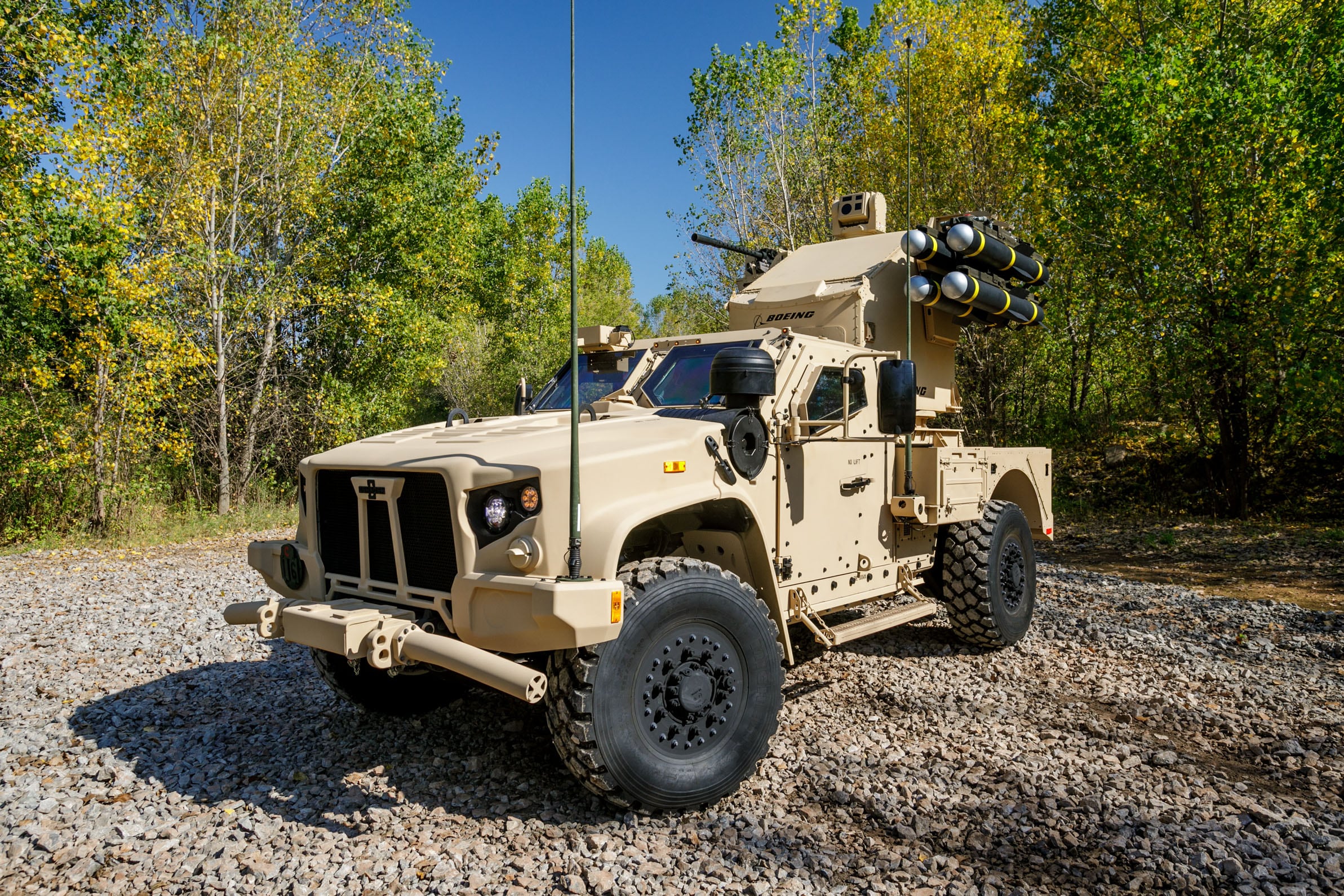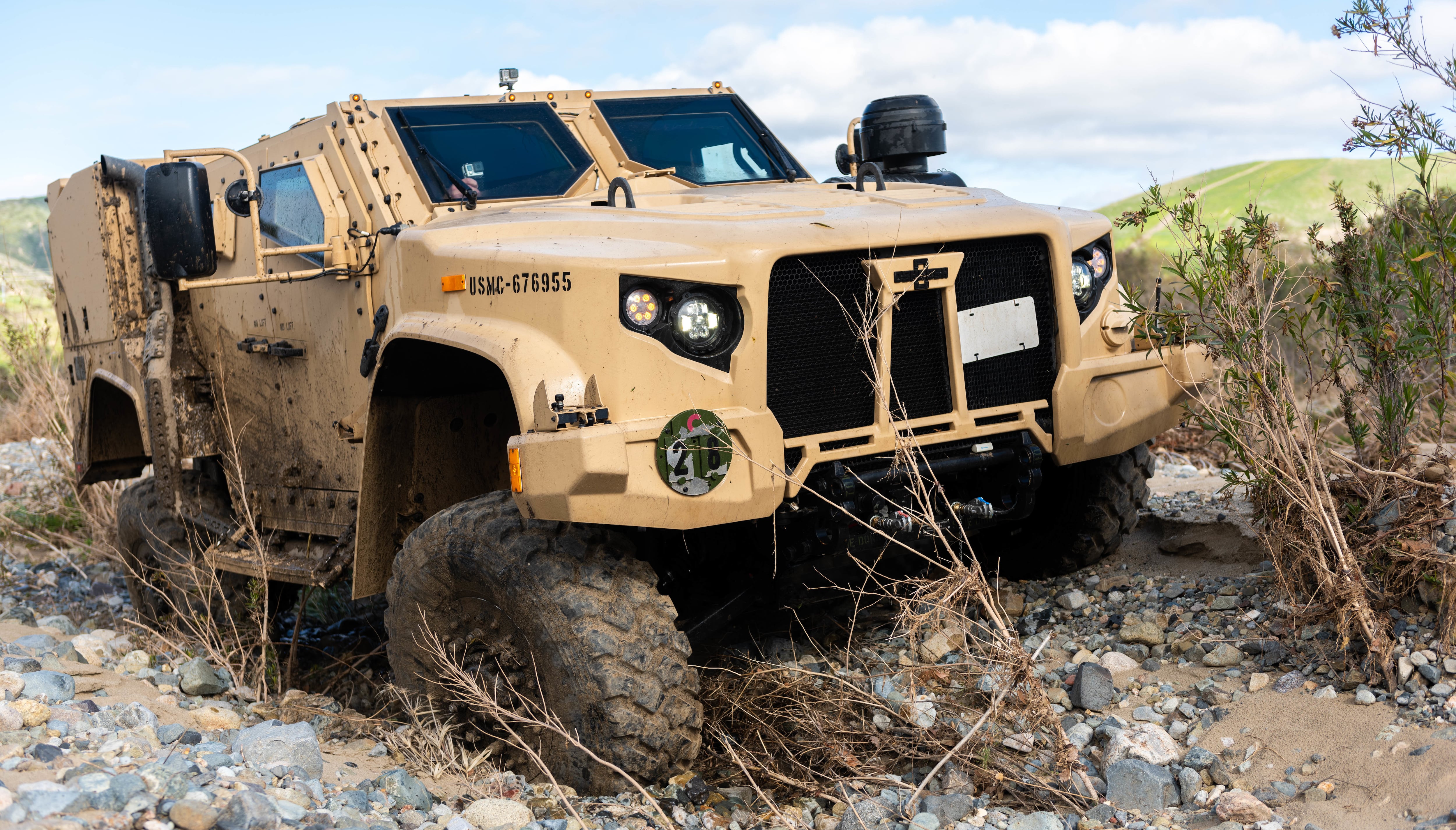The vehicle that both the Marine Corps and Army have pushed to replace the decades-old Humvee as the primary transport for troops on the battlefield has reached initial operational capability a year ahead of its government schedule.
The Joint Light Tactical Vehicle program has fully fielded “battle-ready” vehicles to the following key Marine Corps’ schools: School of Infantry East at Camp Lejeune, North Carolina; School of Infantry West at Camp Pendleton, California; The Basic School at Quantico, Virginia; and the Motor Transport Maintenance Instruction Course at Camp Johnson, North Carolina, according to a Marine release.
The vehicles also have been fielded to an infantry battalion at II Marine Expeditionary Force, according to the release. I MEF and III MEF will begin fielding the JLTV by late September.
“The warfighting capabilities the JLTV provides our Marines far exceed the capabilities offered by its predecessor,” said Program Executive Office-Land Systems’ John Garner.
RELATED

The Marine Corps purchase plan originally called for 9,000 JLTV purchases, or about 60 percent of the Humvee fleet.
That was modified about six months ago, said Barb Hamby, with Marine Corps Systems Command.
“We are now replacing all HMMWVs — 15,390 of them. We will buy through to the early 2030s, depending on funding,” she said.
IOC is beyond simply delivering trucks to the units.
“All of the tools and parts required to support the system need to be in place, the units must have had received sufficient training and each unit commander needs to declare that he is combat-ready,” said Eugene Morin, product manager for JLTV at PEO Land Systems.
In February, Marines at SOI-West were some of the first to see the JLTV in action outside of testing centers. Fifty-five arrived between then and late May to the two SOIs and the Motor Transport Instruction Company.
The first operational unit to get the vehicle was 3rd Battalion, 8th Marines, at Camp Lejeune, North Carolina, in July.
The JLTV’s suite of protection, off-road mobility, modularity and network capabilities exceed the Humvee and provide those assets in a smaller, speedier system than the Mine Resistant Ambush Protected, or MRAP, vehicles developed to counter roadside bombs put into the fleet after Humvees were being demolished by improvised explosives in combat zones in recent decades.
But, the JLTV’s development and fielding did not come off without some shifts in design and changes.
A report published earlier this year by the Pentagon’s Director of Operational Test and Evaluation, which covered testing from 2018 deemed the JLTV “not operationally effective.”
Oshkosh Defense, the JLTV manufacturer, and PEO Land Systems staff quickly rebutted some media reports of the DOTE findings, noting that many of the errors had been corrected before the Pentagon report was published.
But, the findings did prompt some refitting.
The JLTV is made in two- and four-seat versions with four basic configurations — general purpose, utility vehicle, heavy guns carrier and close-combat weapons carrier.
The most glaring problem was the close-combat version “provides less capability to engage threats with the (Tube-launched, Optically tracked, Wire-guided) missiles” over the Humvee, according to the DOTE report.
“The missile reload process is slow and difficult for crews,” according to the report, and the close-combat version has “less storage space than other JLTV variants and accessing mission-essential equipment from the cargo area is a challenge.”
So, as testers compiled the 2018 report, they deemed the close-combat JLTV “not operationally effective,” a term used to determine if the system can accomplish its mission in a realistic environment.
Andrew Rodgers, the Marine Corps’ light tactical vehicle program manager, told reporters in a March phone interview that working with the TOW system on the JLTV would require improved tactics, techniques and procedures by troops getting familiar with the vehicle.
The company also changed storage and access to missiles and added shielding to cables, Oshkosh Defense President John Bryant told Marine Corps Times. Those changes have been incorporated already on the vehicles being fielded.
Defense testers found problems for users exiting the vehicle, noting, “numerous reliability failures of doors not opening impeded the ability of the soldiers and marines to safely ingress and egress the JLTV.”
The armored door system is slightly more complex than the Humvee and takes some experience to learn. So, Rodgers said, designers made changes to the doors.
Testing crews reported, “poor visibility due to blind spots around the vehicle,” in the DOTE report.

“A decision was made back in December for the Army to pursue expanding the visibility of the vehicle, improving size of rear windows, putting a front camera on the JLTV,” Rodgers said.
The DOTE report noted a lack of maintenance capabilities and over-reliance on contractor support to provide maintenance.
“Units cannot maintain the JLTV without support from the contractor field service representatives due to vehicle complexity, ineffective training, poor manuals, and challenges with troubleshooting the vehicle,” according to the report.
The reliability problems included: engine wiring, flat and damaged tires and brake system faults.
Bryant said in the March interview that the vehicle had done more than 100,000 miles of testing and the JLTV was assessed as meeting double the reliability requirement.
The report noted that JLTVs would need more maintenance due to some of their complexity.
But, Rodgers explained that while Humvees can hit operational failures at around the 500- to 600-mile mark, JLTVs’ lowest mileage estimates in testing to those types of failures was 2,400 miles.
So, while fixing the JLTV may be more time intensive and complex, he said that the vehicle will likely run longer with less regular maintenance than the Humvee.
Once operators and maintainers are more familiar with the JLTV, “the reliability of the vehicle will go up, which means there will be less maintenance on the vehicles,” he said.
Compared to the Humvee, the JLTV already needs less maintenance, he said.
In June, the Army approved the JLTV for full-rate production, but only after a six-month delay, according to Military Times sister publication Defense News.
The delay was due, in part, to alterations called for from soldier feedback and the DOTE findings.
But even the delay and alterations did not halt fielding of 300 JLTVs to the Army’s 1st Brigade, 3rd Infantry Division at Fort Stewart, Georgia, Defense News reported.
While the Humvee began service in the 1980s and will continue in different missions for the coming decades, the JLTV could have an even longer shelf life.
“We are really at the starting line right now. Our grandchildren and great-grandchildren will see JLTVs in the DOD,” Rodger said. “We’ll easily still have these assets somewhere in the (defense department) in the year 2100. Welcome to the start of many generations of JLTVs.”
Todd South has written about crime, courts, government and the military for multiple publications since 2004 and was named a 2014 Pulitzer finalist for a co-written project on witness intimidation. Todd is a Marine veteran of the Iraq War.





